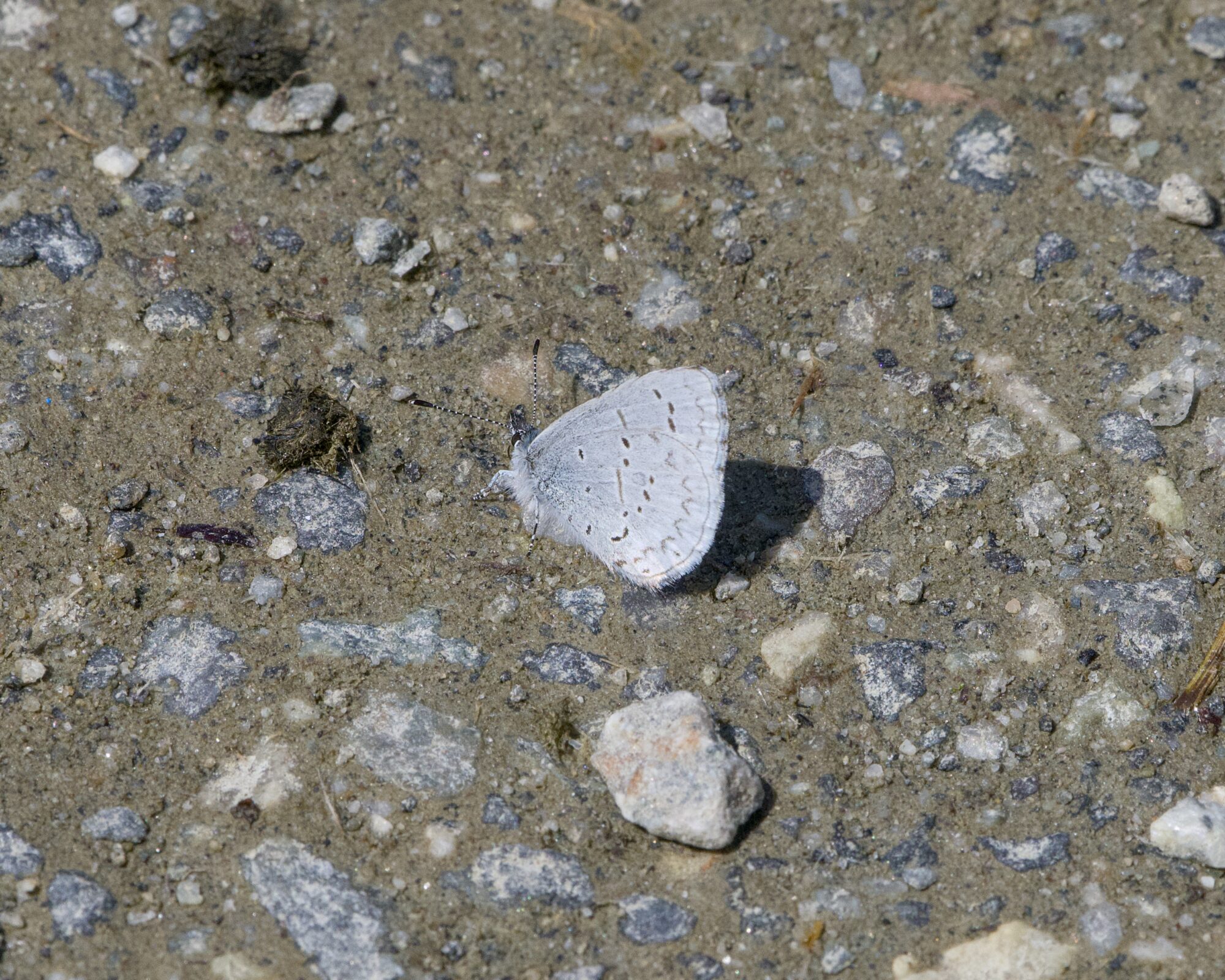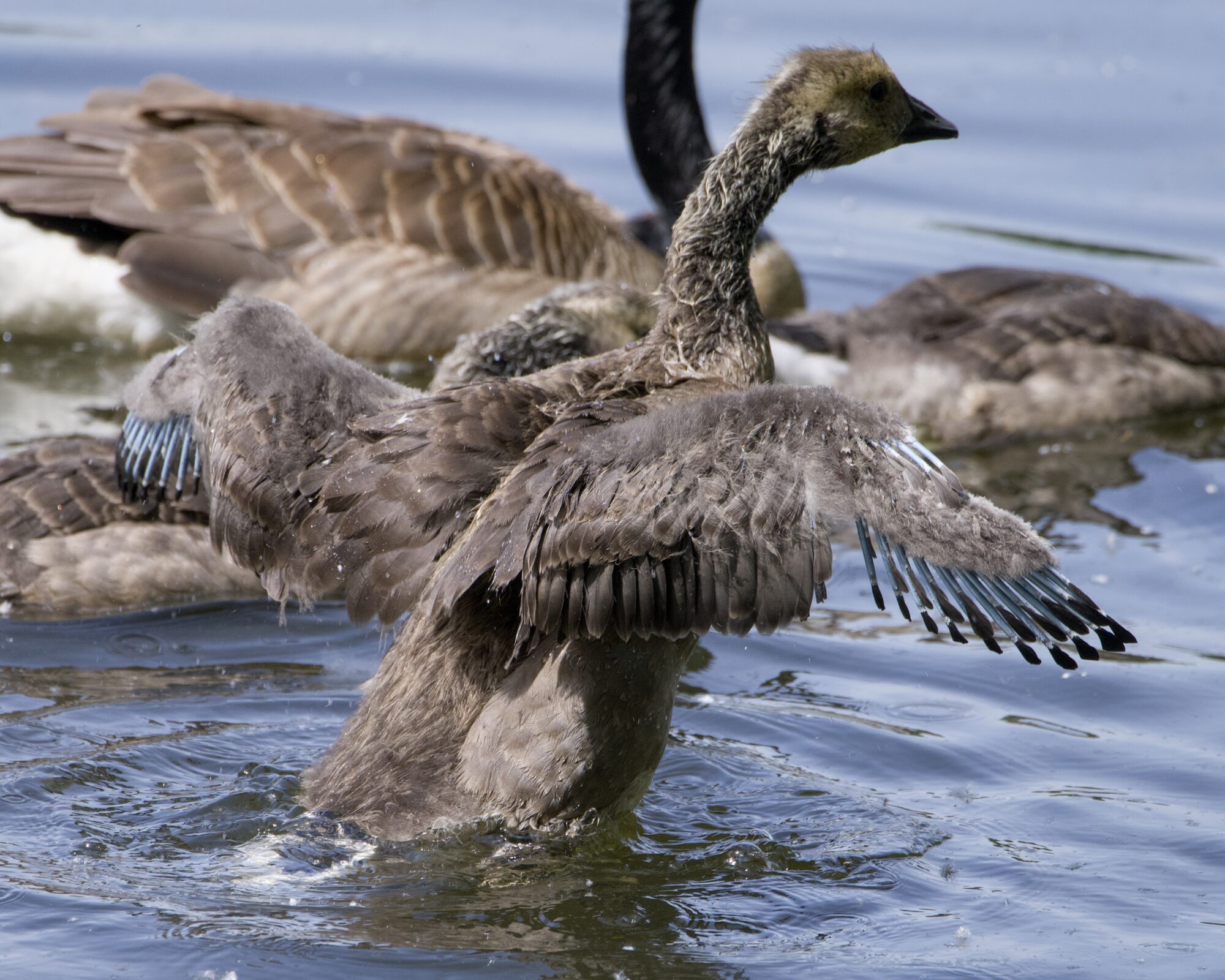1: Burnaby Lake Regional Park
My partner in birding and I did something we hadn’t done in a long time: instead of just stopping at Piper Spit and the Nature House, or walking to and from the Avalon Avenue parking lot at the eastern tip of Burnaby Lake, we did the whole trail circuit, all 10.3km of it.
Our first encounter was with a relatively rare bird: a Swainson’s Thrush! Not quite a lifer for me, I had seen them a handful of times in these parts—but also I’d never taken a photo I’m really happy with. This day was no exception, and I only managed two not-great photos before it flew away. Even the better one took quite a bit of post-processing. Still, that was a nice encounter and a good omen. A rare bird is a rare bird!

On to Piper Spit, and the usual late spring contingent of geese, Wood Ducks and Mallards. I miss the freaky winter ducks, but our year-round resident friends make great subjects! Especially when they’re transitioning to their eclipse plumage, the poor dears, to raise the freaky factor.

And for those that aren’t transitioning yet, or at all, you just need to find the perfect spot to frame their stunning profile. I am just really happy with this shot! It’s cozy and colourful, the duck’s outfit and the scenery complementing each other. It really feels like a fine art print!

It’s also the season of goslings, and their weird and random behaviour.

And my first Cedar Waxwing of the season!

Now here is a rare and precious little bird, a Willow Flycatcher. Not quite a lifer, I’ve seen them a few times around Lost Lagoon, but this was my best photo so far. I wish I’d gotten a bit closer and maybe managed to capture more of their wing details (I know, I’m so picky) but these are shy little birds and would not let me get close even if I were inclined to go off trail, so I’ll take it for now.
I also saw (even further away) a similar bird that Merlin ID’d as a Dusky Flycatcher, which I don’t think is correct. Duskies are supposed to have a prominent white eye ring, but when I zoom in that bird doesn’t have one at all so it’s more likely a Willow. That’s flycatchers for ya: they are incredibly similar in appearance, so determining species from subtle field marks, season and location is as much an art as a science. Though it seems each species’ song is very distinctive, at least, so all I need to do is memorise those damn songs and I’ll be an expert.

And look, this is why I’m glad we went all around the lake, because you do get a bunch of these cozy little views — ideally the pond would have a few ducks, but alas, that wasn’t the case here. In the distance to the right you can see the towers around Lougheed Town Centre, probably 4km away or more. Looking at timestamps, we’re about 25 minutes east of the rowing pavilion, which is near the western end of the lake, much further away than the last time I tried a similar shot.

We saw a few new butterflies! namely, an Echo Azure (scientific name Celestrina echo), a very small powdery blue thing with a smattering of dark dots; and a Milbert’s tortoiseshell, (Aglais milberti) another small one with bold orangey-brown patterns. Good stuff!
(Is there an app to identify butterflies, like Merlin ID? Probably, but reverse image searches work pretty well for now.)


2: Como Lake Park
Tiny Como Lake Park brought both science and adorbsness! First, take a look at this adolescent Canada Goose, looking pretty grown up and probably hatched from the earliest clutches of the season. What are those bluish things at the end of its wings? They’re keratin sheaths, inside which new feathers grow — vital protection for something as exceedingly complex as a feather. I’ve seen these things a couple times, and you’ll find them on birds of all sizes.
Soon this one will have a complete set of flight feathers, but that’s only the start. Actual flight will take a lot more practice! I’m still amazed they manage to do it in just a few months.

My first ducklings of the season! I just love this shot so much. The warm patterns, from its cute fuzzy head to its little webbed feetsies, those little stubby wings, the soft brown eye… it’s perfect!

3: Rocky Point Park
Rocky Point Park in Port Moody has lots of nice scenery but usually not so many interesting birds. The Purple Martin condos out in the water still seem vacant, and the boardwalks on the marshy east end were closed for upgrades. It looks like they’re raising them considerably to allow for higher water levels and rougher floods. Yay for foresight, I guess, but boo for climate change!

And! We ran into a couple people volunteering for some bird group (I forget the name), who correctly identified us as Bird Nerds based on our Big Telephoto Lenses. They mentioned a heron rookery by Old Orchard Park just half a km or so away—much better than the Stanley Park one, apparently since the nests are much closer to ground level. However, after having walked over 10 damn km we weren’t keen to walk more if we could help it. Besides, the rookery will probably be active for about another month. They also mentioned Lazuli Buntings at ƛ̓éxətəm, and gave us directions. Now, I’d heard about these birbs before, but never saw them in person. I’d assumed they hung around the community gardens. But no, apparently you want to stop at the first parking lot just past the train tracks, and there are trees nearby that’ll give you what you need.
4: ƛ̓éxətəm (Tlahutum) Regional Park
So we went looking for those mythical Lazuli Buntings. Unfortunately they remain mythical for the moment. Probably because we both managed to kind of forget the directions, and had very little energy left for just wandering around. We decided to just quickly visit the community gardens and call it a day.
My expectations for the gardens weren’t especially high. The last couple times we only saw a handful of robins and multitudinous Tree Swallows swooping all about and occasionally resting on their nest boxes. Good news, though: there was one single Violet-green Swallow taking a rest on a pole. Bad news: it sat still just long enough for me to take a terrible photo, which I won’t even post here. Booo.
Birds being too difficult, I turned my lens to the many local pollinators. The bright pops of colour and narrow depth of field make for some neat and, dare I say, experimental photos. Who knows, I may even have to add a new gallery to my store!

Last Words
I really, really like a lot of these photos. Like, well enough to put them up on the site. The Wood Duck by the water looks like a painting, as does the bumblebee on those flowers — I’m not used to such strong blocks of colour in my photos! The duckling is adorbs, especially after a bit of cropping to remove some distracting details. And I’m really digging the Cedar Waxwing in the tree, with the blurred foreground foliage. That one feels very artsy too.
The thing is, I find myself pondering more and more what will make a good photo to sell. Composition, colour, subject, action (if it’s an animal). Of course, when it comes to birbs, sometimes you take what you can get. But I’m trying to learn from other photographers, so if I have the chance, why not take the time to compose things nicely, either on site or in post, and tell a bit of a story?
I promise, it’s not about turning into a big capitalist, it’s about pushing my photography skills, and trying to get out of my own head and imagining what other people like. But who knows, it might help me get a sale someday? That’s a nice to have. But meanwhile I’ll keep making all the artsy crops I can.